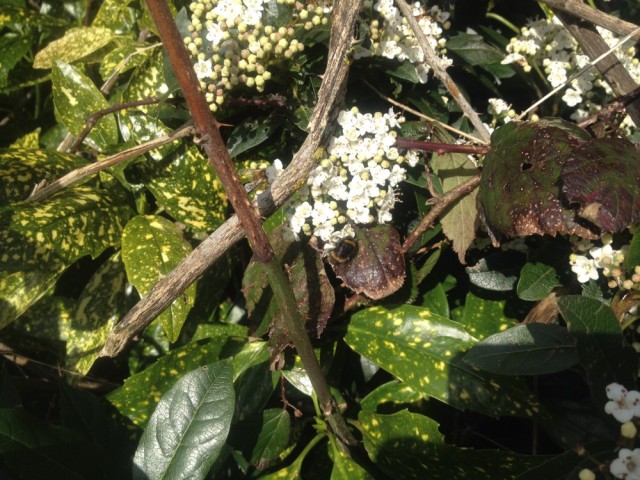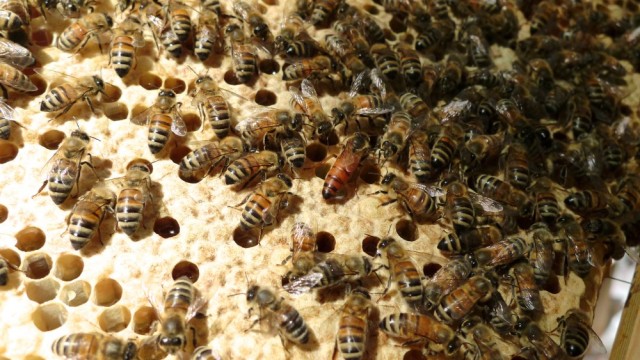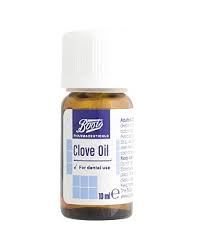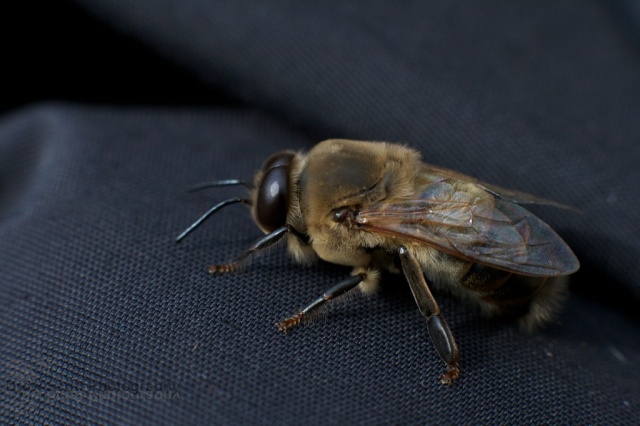As I like to do each year, yesterday I went to the Federation of Middlesex Beekeepers’ Associations annual Bee Keepers’ Day. Each year the Middlesex associations (Ealing, Enfield, Harrow, North London, Pinner & Ruislip) take it in turn to host a day of beekeeping talks; this time it was Harrow’s turn.
My day started well – by missing a train. So I wandered down the empty sunny platform, enjoying the warmth and peace. And found a flowering bush covered with bees and flies – honeybees, a bumble and bluebottles. My first bumble spotting of the year! I inhaled its sweet scent and watched the bees enjoying themselves. Thanks to social media, lots of kind people have told me that this is Viburnum Tinus, a great favourite with bees. Missing the train turned out to be a good thing – it led me to have an encounter with the creatures I was on my way to learn about.
Two tube trains and a bus later, I arrived at Harrow Arts Centre. It has an incredible number of rooms, but a nice girl in the Library showed me where to go – a hut outside with a sign announcing ‘Beekeepers’ at the entrance. Terry Clare, a smartly dressed man with a luxuriant white beard, had just started speaking to a crowded hall. Terry is a Past President of the Bee Improvement and Bee Breeders’ Association (BIBBA). He was complaining at the number of beekeepers who start running training courses after 2-3 years experience, some of them charging extortionate rates like £300-£400 for a day’s course. There were nods and grunts of agreements around the room.
While I found a seat I lost track of things a bit, so notes begin as Terry was talking about the importance of selecting for more than one quality when breeding bees. Apparently German and Russian beekeepers in the 1920s-30s selected for bees with long proboscises that could work certain crops. They succeeded, but the resulting bees had other undesirable characteristics which made them “totally useless”. Terry looks for five characteristics: quiet on comb, non-following, productivity, thriftiness and non-swarming.
Seeing improvements in your bees will take several years. Terry was full of good quotes like this one – “Most problems in beekeeping are resolved when you get home – you find a mirror and look in it – there’s your problem!”
Hygiene and disease
If you’re going to breed queens, first you need healthy bees to work with. Learn what normal comb looks like – both sealed and open. Worry if any frames look different; if you aren’t sure why, ask a more experienced beekeeper or call a National Bee Unit inspector in.
Terry has a special quarantine site for newly captured swarms, where he can keep an eye on them and monitor for diseases. In recent years he has captured two swarms which turned out to be carrying European Foul Brood.
Every beekeeper should have a spare freezer. If you want to store frames overwinter, put them in the freezer for 24 hours, then take out and store in polythene bags. This kills wax moth eggs and larvae.
Varroa treatments
He has doubts whether varroa monitoring with a board is as effective as claimed by many. He has seen virtually clean boards before yet damaged wings and mites on the bees inside. Instead he uses drone uncapping for monitoring and lactic acid as an emergency summer treatment. He found the new Mite Away Quick Strips (MAQs) treatment effective last summer, but is a bit suspicious about it as he lost four queens in nucleuses whilst treating. He will be trying it out again this summer.
Terry uses Apiguard at the beginning of August (after taking his supers off) and only one tray rather than the usual two, as he thinks it can cause damage to brood. He puts the supers back on again after 2-3 weeks to take advantage of the autumn ivy flow. The light, bitter ivy honey is very popular with his customers – “And I don’t argue with customers”. (Another beekeeper commented to me afterwards that they find it disgusting – I enjoyed a little bit Andy gave me once, but then I like grapefruit juice).
Using a brood box as a nucleus
Don’t have a nucleus? You can use two thick insulated dummy boards to make a brood box act as a nucleus. Put 4-5 frames in-between the thick dummy boards and use regular dummy boards to fill out the rest of the space and keep the bees warm.
Finding queens and calming workers
Try to avoid using smoke when looking for your queen. Terry uses a mist spray in a bottle brought from Wilko for 97p! Just a little mist over the top will do – this is standard in many European countries.
My favourite tip of his talk was clove oil. I dab some on my neck when I go beekeeping – not just because I like smelling like apple pie, but because it is supposed to calm bees. Terry goes one step further and puts a couple of drops on a bit of towelling (an old face flannel perhaps?) which he then keeps airtight in a tobacco tin. If the bees get moody whilst inspecting, he puts this towel on top of the frames – the bees will go down and be quiet. Or put the towel in your hands to distract the bees from stinging you. This is a common ruse in Germanic countries.
The importance of drones
When a drone emerges, he needs 12-14 days of flying before he’s ready to mate. His sperm takes time to move down into position and he needs to develop his powerful dorsal muscles by flying. If drones can’t get out during bad weather, these muscles won’t develop fully and he’s unlikely to catch a queen.
Raising lots of good drones is essential. He told us “Any fool can raise queens – I can – but raising drones is a different game altogether”. Use your best queens to raise drones, not queens. Tell others to sacrifice their drones for varroa treatments – but don’t do it yourself! Flood your area with your superior drones. But never use the same queens two years in succession to produce drones.
To raise good drones, your bees require access to plenty of food. If the workers run short of food, they’ll throw the drone brood out. To feed the developing brood, you also need lots of young workers under three weeks old, as they do the feeding.
Feeding
The best food to feed with is the bees’ own honey. If you’re serious about doing this, try putting a brood box (with a queen excluder underneath) on instead of a super during the summer. The bees will draw out a very heavy brood box of honey comb, which you can then keep over winter in the freezer ready for spring feeding.
Terry also uses a ‘water-dip’ method. This involves soaking a bag of granulated sugar in water for 3 seconds, then inverting it over the crown board. Feed in the evening to prevent any spills causing robbing.
Finally – the Queen
As with the drones, to produce good quality queens your young bees must be well fed. You will need reliable records, an assessment system, wide gene pool, a timetable plus an abundance of drones. Floods, wars, weddings, bereavements, football penalties etc should not affect the timetable.
Terry told us a sweet story about a young man who asked a beekeeper for permission to marry his daughter. He was told yes – but that there were no summer weddings in their family! I have messed up a bit as I’m getting married in May, just as swarm season kicks off! Whoops.
A quite unusual characteristic which Terry has been selecting for is supersedure. He mentioned an American study which had found supersedure happens naturally in about 10% of colonies – whereas about 40-60% of his colonies supersede (replace) their queens with newer ones. I suppose this saves him the work of having to do it.
To raise quality queens, you want queens raised from one day old larvae, so that they are fed copiously from the very beginning of their lives with royal jelly. The better fed a developing queen is, the better developed her ovaries will be for egg laying. You can force the bees to do this by dividing a colony in some way (like a split, artificial swarm, demaree or Shepherd swarm box – Terry’s favourite). You divide young bees into a separate hive box and remove the queen. Early on the 3rd morning afterwards, at 6 or 7 am, remove any queen cells in their box. This will force the workers to use newly hatched larvae to raise new queen cells.
Terry disagrees with the books, which often say a queen can mate within 28-32 days – he thinks she must mate within a fortnight of emerging and after that “goes stale”.
And that’s all folks
Terry was a very entertaining and jolly speaker, there was lots of laughter from the audience. I don’t plan to raise queens, but even so I picked up lots of practical tips, like the clove oil towel. David Aston spoke about the relationship between bees and flowers after lunch, so I’ll cover his talk in my next post.








‘drone recapping for monitoring ‘. I think you mean ‘uncapping’. Terry was President of BIBBA – I became President last year.
Brian P. Dennis.
LikeLike
Hello Brian, thank you for your comment, I’ve updated the post to correct both mistakes.
LikeLike
Hello Emily, gosh, what a detailed posting on Terry’s talk, really good, thank you. I was there yesterday, interesting wasn’t it? What a lovely apiary they have at Harrow, too. Such nice folk.
I was fortunate enough to travel back to Euston with David Aston and enjoyed our conversation very much – also his talk, look forward to your post on that!
LikeLike
Lucky you getting to travel back with David! I’ll try to write up his talk soon while it’s still fresh in my mind.
LikeLike
Great blog, each one I read captures me, you ever thought about writing a book.
Do you know if Terry has written a book ?
LikeLike
Thanks Phillip, but all I’ve done is written down Terry’s excellent advice. Now you mention it, my beekeeping partner Emma and I may do an e-book together. I don’t know of any books by Terry sorry.
LikeLike
I hope you do write one, willing proof reader here 🙂
LikeLike
Hi Emily.
I’m a new member of the Harrow Bee keepers (3yrs) with one hive, i would like to thank you for your report as I was unable to attend, but reading it here it felt like I had!
Many thanks.
Jim Hughes
LikeLike
Thanks Jim, that’s nice of you to say. That’s partly why I do these posts, so that people around the world who couldn’t come can benefit from the advice. And so that I can look back after I’ve forgotten it all (terrible memory!)
LikeLike
That is a fascinating and informative post, even for a non-beekeeper. I loved the comment about looking in the mirror to identify problems you have with beekeeping- that applies to so many other areas of life too! I was intrigued by the use of clove oil too, my grandmother used to recommend it for flea problems too – and it’s great for helping to soothe toothache (maybe after eating too much honey?) Best wishes
LikeLike
Thanks Theresa, I was a little worried it would be too technical for my non-beekeeper readers to follow! Funnily enough honey never gives me a toothache, but if it ever does I now have some clove oil handy 🙂
LikeLike
Thank you for posting this one. I don’t like to smoke the bees but didn’t know any alternatives until now. I will have to try clove oil this season.
LikeLike
Yes, I’m intrigued to try the clove oil one too. In conjunction with the mist spray, which I’ll put some weak sugar syrup in.
LikeLike
I read somewhere, sorry don’t remember where, that smoking interferes with the alarm signals of the bees and that is why smoking calms the bees. A second hypothesis I’ve read is that smoking the bees makes them think that there is a fire and this causes them to take up a lot of honey so the hive can relocate and that the bees full of honey, like swarming bees are less aggressive.
I don’t know which of the two is more likely or if there is a third/better hypothesis, smoking works, I just try to be sparing.
I’ll have to see if I can find any clove oil to and try that…ty
LikeLike
I’ve heard both theories too. Without being able to ask the bees, perhaps we will never know for sure which is right. I usually smoke too, but as our bees are very gentle, I usually only need to use the smoker when closing the hive up.
LikeLike
Sounds like it was an interesting and informative presentation. I’ve saved your notes for reference.
LikeLike
It was indeed 🙂
LikeLike
I’ve just discovered your blog (after doing some bee-related research yesterday) and it’s a delight! Lovely photos and easy to read for a non-apiarist!
LikeLike
That is really kind and means a lot, thanks! Let me know if you need any help with the research.
LikeLike